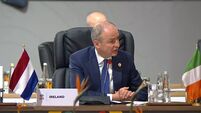Trebling of applications for international protection linked to 'catch-up migration'

In the first six months of this year, 6,494 applications for international protection were lodged in Ireland — a significant increase compared to the 2,235 applications in the first half of 2019. File picture: Valerie O’Sullivan
The near-trebling of applications for international protection in the first half of this year has largely been driven by catch-up migration following the Covid pandemic and Russia's invasion of Ukraine.
The findings are contained in a new analysis by the Economic and Social Research Institute (ESRI) of the soaring numbers of applications, finding current labour market shortages here may also be contributing to the rise.
In the first six months of this year, 6,494 applications for international protection were lodged in Ireland — a significant increase compared to the 2,235 applications in the first half of 2019, the last year not impacted by the Covid-19 pandemic.
According to the ESRI report, published on Thursday: "Travel restrictions throughout the Covid-19 pandemic significantly reduced international migration for two years. With a sharp jump in applications from February 2022 onwards, Ireland may be seeing a form of ‘catch-up migration’.
"At the same time, the pandemic has also had economic impacts on countries globally, which has complex effects on migration patterns."
The report, entitled , outlines how most of those displaced from Ukraine due to the Russian invasion are covered under the Temporary Protection Directive and so are not counted in application figures.
However, the report said the knock-on effects of the war on neighbouring countries and on socio-economic conditions in many other countries may be contributing to the increase in applications in Ireland.
"The research identifies that for many of the top nationalities applying for international protection in Ireland, including Somali, Afghan, Ukrainian, Egyptian and Georgian, conditions and conflict in countries of origin are important drivers. Applications from these nationalities are increasing not only in Ireland, but across Europe," it said.
And the report said: "The movement of refugees from other EU member states to Ireland also appears to be playing a role in Ireland’s increase, although it is difficult to draw concrete conclusions because the available data is limited.
"Key reasons for this type of movement may include reuniting with family, living conditions in the first EU member states, as well as limited possibilities for intra-EU mobility."
Policy changes in the UK, which has limited the movement of people following Brexit, is unlikely to be a factor, according to the ESRI, although it said there may be a "small deflection effect for certain nationalities", such as those from South Africa and Zimbabwe, coming here instead of to our nearest neighbour.
It also cited the labour shortage situation here, but said no single factor was responsible for the sharp rise in applications so far this year.
"The White Paper on ending direct provision was based on a figure of 3,500 new applicants a year, however, this report has shown that international protection applications tend to vary significantly, and so our reception systems need to be designed with this in mind.”













